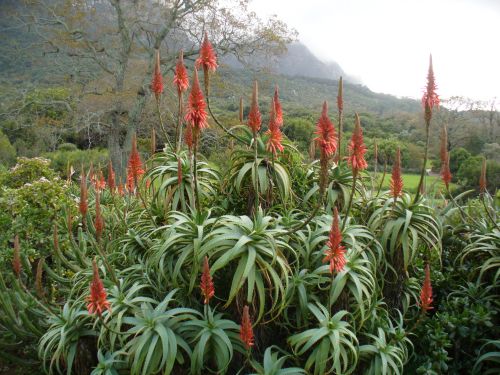Update 11 juli 2014: Roos maakt een opmerking in reacties waarop ik een antwoord heb gegeven, zie reacties. Ook een foto toegevoegd van de Aloë Arborescens plant.
Interessant lijkt ook deze studie eens te bekijken waarin Aloë Arborescent extract succesvol wordt gebruikt bij aandoeningen in slokdarm en bovenste gedeelte van de maag: Candelabra aloe (Aloe arborescens) in the therapy and prophylaxis of upper respiratory tract infections: traditional use and recent research results. waarvan het volledige studierapport tegen betaling is te verkrijgen: http://link.springer.com/article/10.1007%2Fs10354-012-0171-3
Het abstract van bovenstaande studie plus uitgebreide referentielijst heb ik onderaan dit arikel toegevoegd:
22 juni 2009: Bron: 1: In Vivo. 2009 Jan-Feb;23(1):171-5
Een abstract gemaakt van de Aloe Vera plant geeft aanvullend op verschillende vormen van chemo therapie bij verschillende vormen van uitgezaaide kanker een signicant beter effect op de 3-jaars overleving en op de controle over de ziekte. Dit blijkt uit een gerandomiseerde studie met 240 kankerpatienten. Het volledige studierapport is hier digitaal te bekijken of downloaden.
Er deden patienten aan deze studie mee met vergevorderde niet-klein-cellige longkanker, darmkanker, alvleesklierkanker en maagkanker Opvallend dat er 12 complete remissies waren in de Aloe groep van 119 patienten tegenover slechts 4 complete remissies met alleen chemo onder 122 patienten. De controle van de ziekte (stabiele ziekte) bleek bewerkstelligd bij 80 van de 119 in de Aloe plus chemo groep en bij 60 van de 121 bij de chemogroep. Een significant verschil.
By considering the overall tumor histotypes, the percentages of complete responses (CR) and partial responses (PR) achieved in patients concomitantly treated with aloe were significantly higher than in those who received chemotherapy alone (40/119 (34%) vs. 23/121 (19%), p<0.01). A CR occurred in 12/119 (10%) patients concomitantly treated with aloe and in only 4/121 (3%) patients treated with chemotherapy alone. This difference was statistically significant (p<0.01). Stable disease (SD) was achieved in 37/121 (31%) patients treated with chemotherapy alone and in 40/119 (34%) patients who received a concomitant aloe administration. The disease control (DC=CR+PR+SD) obtained in patients concomitantly treated with aloe showed a significantly higher percentage than that found in patients who received chemotherapy alone (80/119 (67%) vs. 60/121 (50%), p<0.0l).
A. arborescens may be considered a valuable addition to the spectrum of herbal medicinal products for the treatment and prophylaxis of upper respiratory tract infections, in particular common cold, in adults and children.
Candelabra Aloe (Aloe arborescens) in the therapy and prophylaxis of upper respiratory tract infections: traditional use and recent research results
Summary
Aloe arborescens (Candelabra Aloe) has been used in the treatment of upper respiratory tract infections in Central and Eastern European countries for many decades. Originally introduced to support the healing and recovery in cornea transplant patients, aqueous A. arborescens extracts soon became popular in the treatment of upper respiratory tract infections with a focus on toddlers and children. Recent preclinical and clinical data show that immunomodulatory, antiinflammatory, and antiviral effects contribute to its therapeutic efficacy. Based on its well documented, longstanding traditional use and its excellent safety and tolerability, A. arborescens may be considered a valuable addition to the spectrum of herbal medicinal products for the treatment and prophylaxis of upper respiratory tract infections, in particular common cold, in adults and children.
Zusammenfassung
Aloe arborescens, die Baumaloe, wird in Mittel- und Osteuropa seit vielen Jahrzehnten bei Erkrankungen der oberen Atemwege eingesetzt. Wurden Zubereitungen aus Baumaloe in den 1930er Jahren zunächst zur Unterstützung der Heilung und Rekonvaleszenz bei Cornea-Transplantationen eingesetzt, spielte schon bald ihre Anwendung bei Atemwegserkrankungen von Kleinkindern und Kindern eine wichtigere Rolle. Neuere präklinische und klinische Daten zeigen, dass immunmodulatorische, entzündungshemmende und antivirale Effekte zur Wirksamkeit von Aloe arborescens beitragen. Aufgrund ihrer jahrzehntelangen gut dokumentierten Anwendung und ihrer sehr guten Verträglichkeit können Zubereitungen aus Aloe arborescens eine wertvolle Ergänzung des Spektrums pflanzlicher Arzneimittel für die symptomatische Behandlung und Rezidivprophylaxe von Erkältungskrankheiten bei Erwachsenen und Kindern darstellen.
References:
Plaats een reactie ...
3 Reacties op "Aloe extract van de Aloe plant naast chemo geeft significant meer 3-jaars overlevingen bij patienten met uitgezaaide kanker, significant meer complete remissies en significant betere controle van de ziekte dan alleen chemo."
Gerelateerde artikelen
- Aloe extract van de Aloe plant naast chemo geeft significant meer 3-jaars overlevingen bij patienten met uitgezaaide kanker, significant meer complete remissies en significant betere controle van de ziekte dan alleen chemo.
- Aloe Vera gel geeft geen enkel positief effect op voorkomen en herstellen van bestralingsschade aan de huid, blijkt uit twee gerandomiseerde fase III studies
- Aloe Vera naast chemo bij solide tumoren geeft significant beter effect in verkleinen tumoren en geeft mediaan langere levensduur. Blijkt uit gerandomiseerde fase III studie. Artikel geplaatst 9 maart 2010




Wat is Aloë Vera?
Aloë Vera is een plant, die al eeuwen wordt gebruikt vanwege zijn cosmetische en therapeutische eigenschappen. Ondanks zijn cactusachtige uiterlijk is Aloë Vera een plant, die behoort tot de familie van de lelies. Er groeien in de wereld meer dan 250 soorten Aloë. Hiervan worden twee soorten commercieel geteeld namelijk Aloë Barbadensis Miller en Aloë Arborescens Miller.
De bladeren van de Aloë plant groeien vanuit de basis in een rozet patroon. Volwassen planten kunnen een hoogte bereiken van 75 tot 140 centimeter. Een volwassen plant heeft gemiddeld 12 tot 16 bladeren, die per stuk wel 1,5 kilo kunnen wegen. De bladeren kunnen iedere 6 tot 8 weken geoogst worden, waarbij zorgvuldig per plant 3 of 4 bladeren worden afgesneden.
Bron: http://www.cruydhof.nl/aloe%20onderzoek.htm
Kees Braam
webmaster
Een kleine correctie op de teksten:
Aloë vera is de geldige naam voor A. barbadensis. Dus het is één soort binnen het geslacht Aloë.
Ergens in de tekst werd geschreven over " een andere variëteit". Hier wordt ook soort bedoeld!
De soortnamen beginnen altijd met een kleine (onderkast) letter.
Met een vriendelijke groet, J.T.